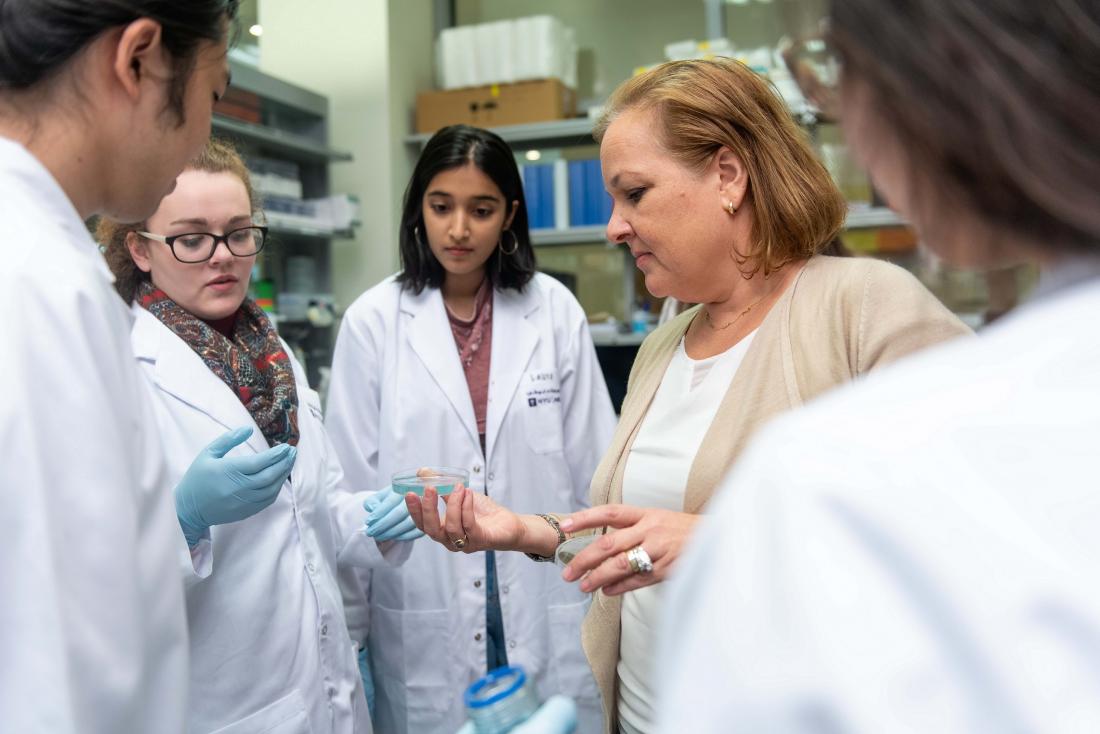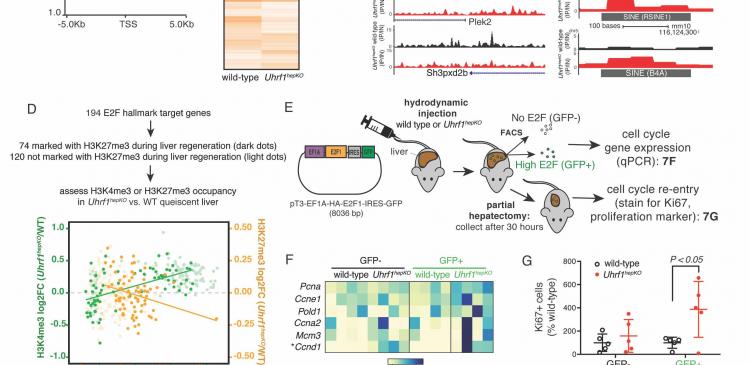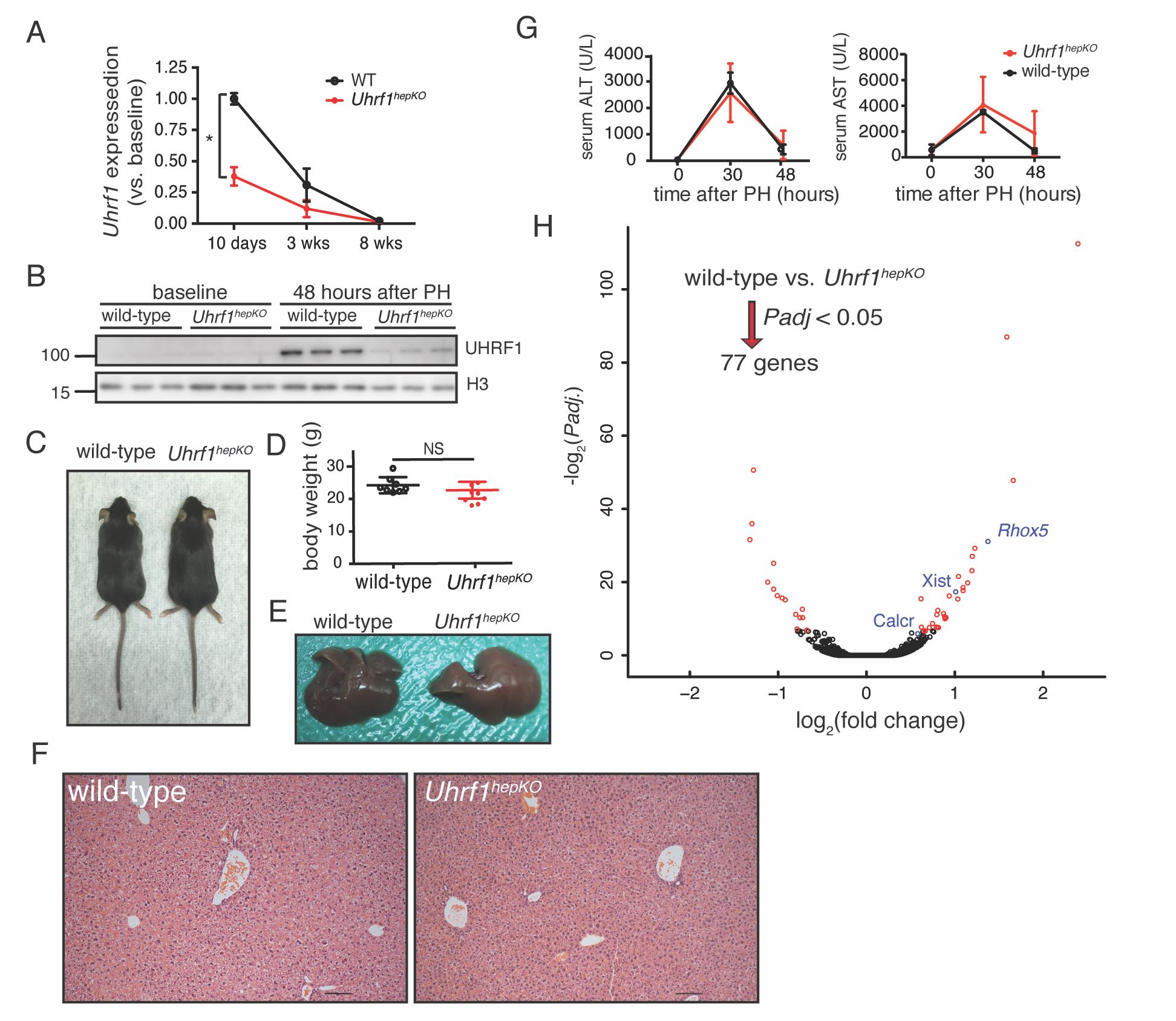Researchers from NYU Abu Dhabi’s Sadler Lab, led by Associate Professor of Biology Kirsten Sadler Edepli. Courtesy NYU Abu Dhabi.
Fast facts:
● The liver is the only solid organ that can regenerate itself in mammals, but what confers this special property to the liver has not been uncovered, despite decades of research.
● NYU Abu Dhabi researchers suggest that a novel mechanism driven by the epigenome promotes liver regeneration.
● The epigenome refers to the code that packages the DNA so that some parts can be activated (i.e. genes) and some parts remain in dormant domains - these dormant parts largely contain remnants of old viruses or transposable elements.
● Epigenetic compensation is when parts of the epigenome that usually have one role - i.e. to suppress genes, are co-opted to do a different job - when another part of the epigenome is missing modifications in the packaging material of the DNA influence how much a genetic program is active or repressed. These modifications do not change the DNA sequence, but instead, affect how cells read genes.
● This study reports that the primary role of the epigenome is to protect the genome against the activation of genomic parasites (transposable elements).
● The new findings have been published in the journal Developmental Cell.
Abu Dhabi, June 21, 2019: In a recent study published in the journal Developmental Cell, NYU Abu Dhabi researchers have reported a new way in which the liver is primed to regenerate itself. They found that by stripping parts of the epigenome, which play a primary role in repressing “jumping genes” (i.e. transposable elements), other epigenetic marks were redistributed.
This newly discovered form of epigenetic compensation protects the genome against transposable elements activation, but takes these compensating epigenetic marks away from their normal job in regulating gene expression. The result is that when these marks are taken away from their normal role, the genes they usually repress are activated early and are sustained during the regenerative response to the surgical removal of part of the liver.
This type of surgery is relevant to humans, as it is used in resection of liver tumors and the regenerative response is essential for the liver to respond to damage. The findings are a significant advance in the understanding of the liver regeneration process, which is unique among the organs of humans, mice, and other mammals.
The researchers from NYU Abu Dhabi’s Sadler Lab, led by Associate Professor of Biology Kirsten Sadler Edepli, removed a key epigenetic regulator, UHRF1 in the mouse liver. They found when they removed part of the liver, the remaining lobes responded more readily by activating pro-regenerative genes activated earlier, and this regeneration program stayed active longer, resulting in enhanced liver regeneration.
The epigenome refers to the code that packages the genome so that some parts can be activated (i.e. genes) and some parts remain in dormant domains - these dormant parts largely contain remnants of old viruses or transposable elements, which were made famous by the 1983 Nobel Prize discovery by Barbara McClintok.
Surprisingly, instead of causing massive activation of transposable elements or an immune response to mitigate the unleashing of transposable elements, as found in previous experiments, they discovered that there is an extra layer of protection by another repressive epigenetic mark (H3K27me3). This mark was redistributed from gene promoters to suppress transposable elements when DNA methylation was missing, thereby compensating for the loss of DNA methylation. When this mark is redistributed, it is removed from its role in repressing genes that promote liver regeneration. Thus, livers lacking UHRF1 are able to regenerate faster.
“When H3K27me3 compensates for the loss of DNA methylation, this results in a favorable epigenetic environment for liver regeneration,” said Sadler Edepli. “It will be exciting to explore whether drugs that can modify the epigenome have the potential to induce epigenetic compensation and increase the liver’s ability to regenerate in cases of liver disease or failure.” Shuang Wang, a post-doctoral fellow in the Sadler Edepli laboratory who worked in her group at Icahn School of Medicine at Mount Sinai, led the study in collaboration with members of the lab at NYUAD as well as Emily Bernstein and Amaia Lujambio in NY.
-ENDS-
About NYU Abu Dhabi
NYU Abu Dhabi is the first comprehensive liberal arts and science campus in the Middle East to be operated abroad by a major American research university. NYU Abu Dhabi has integrated a highly-selective liberal arts, engineering and science curriculum with a world center for advanced research and scholarship enabling its students to succeed in an increasingly interdependent world and advance cooperation and progress on humanity’s shared challenges. NYU Abu Dhabi’s high-achieving students have come from 120 nations and speak over 120 languages. Together, NYU's campuses in New York, Abu Dhabi, and Shanghai form the backbone of a unique global university, giving faculty and students opportunities to experience varied learning environments and immersion in other cultures at one or more of the numerous study-abroad sites NYU maintains on six continents.
Media Contact:
Maha Ayash
Four Communications
[email protected]
+971 55 178 3906
(A) Heatmap showing a global decrease in H3K27me3 IP/IN signal in promoter of all genes but no change in H3K9me3. (B) H3K27me3 IP/IN signal for all promoters shown as scatter plot. (C) H3K27me3 IP/IN signal for all promoters broke down into quartiles and displayed as box-and-whisker plots. Error bars represent s.d. (D) Heatmap showing overall loss H3K27me3 IP/IN signal from 153 K27+ cluster 6 genes. (E) Heatmap showing overall loss H3K27me3 IP/IN signal from 82 K4+K27+ (bivalent) cluster 6 genes. (F) UCSC genome browser view of 6 H3K27me3- regulated E2F targets from (E) that lost H3K27me3 and gained H3K4me3 in the promoter region in Uhrf1hepKO livers. Courtesy of the researchers.
(A) Cartoon illustration depicting where the flox sites are engineered within the Uhrf1 gene locus. (B) Cartoon illustration depicting where the stop codon is engineered with respect to known domains in the UHRF1 protein in Uhrf1hepKO mice. (C) PCR amplification of the Cre transgene gDNA isolated from various tissues of Uhrf1hepKO mice (primer sequences found in supplementary table) with the 422 bp amplicon indicates presence of the Cre transgene and the 3957 bp amplicon corresponding to the wild-type allele. (D) PCR amplification of Uhrf1 floxed or the corresponding WT alleles from gDNA isolated from whole liver tissue of homozygous floxed (Uhrf1fl/fl), heterozygous floxed (Uhrf1fl/+), or WT (Uhrf1+/+) mice. (E) UHRF1 protein detected by immunofluorescence in WT or Uhrf1hepKO mouse liver cryosections at 36 hours post-PH (N=1). (F) Expression of Uhrf1 in the liver of WT or Uhrf1hepKO mouse at 40 hours post-PH (time-point of maximum Uhrf1 detection in regenerating liver of WT mice) detected by RNAseq as displayed on UCSC genome browser (N=1). Error bars represent s.d. Courtesy of the researchers





